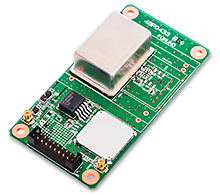Articles for ITS market Semiconductor shortage exposes realities of the automotive industry
A series of automobile production reductions
Since the end of 2020, reports with the title "Production cut due to semiconductor supply shortage" have become more and more common.
The term "semiconductor" may conjure up images of the IT industry in many people's minds, but this time it is the automobile industry that is facing production cuts.
Automobiles are made up of tens of thousands of parts, and one group of them is called actuators. For example, there are fuel injectors for the engine, automatic transmissions, power windows, and satellite positioning systems such as car navigation. There are about 20 to 30 microcomputers installed, even in inexpensive vehicles and nearly 100 in a luxury car. The microcomputers are interconnected by an on-board communication network called CAN (Controller Area Network).
The internal structure of those microcomputers consists of CPUs, RAMs and Flash memories in a single IC (Integrated Circuit), so a shortage of semiconductor supplies has a great impact on automobile industry.
So why did the shortage of semiconductor supply occur at this particular time?
Some media reports stated it was because of increased demand not directly related to the automotive industry Instead it is related to the growing demand for e.g. base stations of 5G networks.
However, when we actually talked to automakers, we found out that the cause was quite simple, how their purchasing operation (supply chain) works.
It was Toyota who answered this question.
Toyota's system to be “unaffected”
At Toyota’s online financial results briefing for the third quarter of this fiscal year, the press naturally raised questions about the impact of the semiconductor shortage on production.
In response, the executive officer in charge of accounting assured that there would be no particular impact.
This statement was quite a surprise to the press, as well as to others in the automotive industry, with the exception of Toyota.
While almost all automakers are experiencing the semiconductor shortage on their production, Toyota, who has returned to the top in vehicle production terms in the world by 2020 (calendar year), said that they were not affected.
Why is Toyota the only one "not affected"?
Toyota's executive officer in charge of accounting gave a perfectly simple answer.
"Because we have been communicating closely with parts suppliers on a regular basis. He added, "We have a system in which the Toyota head office (purchasing department) communicates directly and regularly not only with Tier 1, but also with Tier 2, Tier 3 and Tier 4.
"In some cases, we call tier 1 and other tiers more than 10 times a day."
Tier refers to component manufacturers, with Tier 1 being major component manufacturers such as Denso, while semiconductor manufacturers corresponding to Tier 2.
Generally, contact with Tier 2 is handled by Tier 1 and automakers seldom negotiate directly with Tier 2.
As for the purchasing plan for Tier 1 and Tier 2, Toyota says, "We formulate a long-term plan up to three years, and make minor adjustments in the short and medium term depending on the situation.
This is the reason why Toyota managed to avoid the semiconductor shortage due to its unique production system, "Just-in-time", a meticulous and comprehensive management of all processes from purchasing to parts delivery.
By the way, in the case of Nissan, who announced its financial results the day before Toyota's, the Chief Operating Officer (COO) stated, "Based on the general purchasing cycle, we expect the shortage of semiconductor supplies to be resolved around May 2021.
Will the supply chain really change?
Considering the direct cause of the recent shortage of semiconductor supplies to the automotive industry included the difficulty in predicting component procurement due to the rapid decline and subsequent, upcoming recovery in automobile sales caused by the COVID19.
On a global scale, China was the first country to see the change in the market. Although the urban lockdowns across China caused a significant drop in sales in the first quarter, the second quarter saw an early and significant increase.
In the U.S., which has the largest number of coronavirus cases in the world, sales began to show a gradual recovery late in the second quarter. In Europe, the speed of recovery is lower than in China and the U.S., but the upward recovery trend is clear.
Meanwhile, in Japan, even under the emergency declaration of the first wave of coronavirus, Toyota's sales declined only about 60% from the same month of the previous year. From the beginning of autumn, sales have continued to surpass the same month last year.
These sales conditions, which differed greatly from one region to another, created production plan difficulties in each country and for export. Against this background, the Toyota style management, which consists of sales forecasts, production adjustments, and parts purchasing strategies, perform perfectly.
On the other hand, there seems to be a view among some in the automotive industry that the recent crisis will lead to more awareness of the importance of semiconductors and as a result, accelerate changes in the supply chain of the automotive industry.
It is true that the number of on-board microcontrollers has been increasing in recent years, creating the growing presence of semiconductor manufacturers in the automotive industry. However, the author feels skeptical due to the following two trends.
The first trend is to significantly reduce the number of on-board microcontrollers. As Bosch, a Germany automotive component manufacturer advocates a shift to centralized on-board control systems in the future, including support for server security.
Secondly, there is feedback from CASE (Connected, Automated, Shared and Service, Electric) and MaaS (Mobility as a Service), semiconductor companies like Intel, Mobileye (an Israeli venture under Intel) and NVIDIA (a U.S. company making GPU). They are stating that "the business we should focus on from now is not the sale of hardware and software, but the construction of infrastructure businesses that analyze aggregated data and provide new service platforms.
Of course, these "innovative data businesses" are not the same concept that Toyota mentioned as "people’s connections" to "make more than 10 calls a day to Tier 1 and Tier 2 companies to synchronize production status". This is a different approach.
Nevertheless, it is obvious that the semiconductor supply shortage problem has unexpectedly exposed the obsolete form of supply chain management in the automotive industry.
Writer introduction

Mr. Kenji Momota Automotive journalist
His major is the world automotive industry and he is also familiar with the energy industry, IT and the aging society problem as the related fields. He acts around the world based in Japan and USA and writes for the general magazines, the technology journals and the automotive related media etc.
He is also commentator of motor race and world's motor show on TV program based on his career of the driver of Indy Racing League and NASCAR. In recent years, he has been covering about a paradigm shift from developed countries to developing countries, the motorized vehicle like EV and the telematics.
FURUNO ITS Journal
Click here for the latest articles after 2022 (in Japanese)2022
- The "realistic" self-driving roadmap shown by the Japanese government and a hands-on report on the latest Subaru EyeSight X
- Will FCVs (Fuel Cell Vehicles) Become Popular? ~New Movement in Toyota and Honda~
- The 'Complete' online sales of new cars start in Japan. Will this new way of buying cars take root?
- Many Firsts! On-Site Report from Tokyo Auto Salon 2022 - The author, who knows what goes on behind the scenes, looks back on 40 years of history. -
2021
- "Moving toward zero traffic fatalities for four-wheeled and two-wheeled vehicles globally in 2050" ~Experience on Honda's latest safety technologies~
- Tsuneishi Shipbuilding's building and DX, an exclusive visit to the main factory
- Japan's Smart City: New Moves toward Practical Use
- When will self-driving buses (service cars) be put to "full-scale" practical use?
- Utilization vehicle data during disasters
- Toyota-led Connected Technology to Transform Commercial Vehicle Business -From light trucks to large trucks and buses-
- Toyota enters the connected car "Personalization" business
- Japanese automakers' carbon-neutral strategies swept up in ESG investment
- Drive experience of the latest autonomous vehicle models and advanced driving support systems
- Will carbon neutrality accelerate the trend to strengthen LCA (Life Cycle Assessment)?
- Semiconductor shortage exposes realities of the automotive industry
- Online Autonomous Driving Contest Enhancing development of Human Resources
2020
- What happens to CASE when gas cars are banned in Japan?
- When will Flying Cars be launched?
- Expectation vs. reality:Autonomous Driving in Japan
- V2X, Becoming increasingly important in autonomous driving
- Technology of Subaru “EyeSight X”
- Lifestyle-oriented French cars gain popularity in Japan
- Human-oriented smart cities are wanted
- MaaS and CASE, how would automotive industry change after COVID-19?
- The beginning of virtualization era, triggered by COVID-19
- Trend of EV shift and consumer demands
- TOYOTA Press conference about ADAS - Releasing algorithm for "sudden acceleration suppression during attempted sudden acceleration" free of charge -
- The Japanese automotive industry in 2020 - 3 turning points -
- "Using a smartphone while driving" and "Level 3 automated driving"
2019
- Motor show business model is at a turning point - Tokyo Motor Show Report -
- Commercialization and monetization of MaaS - ITS World Congress Singapore Report -
- Android Automotive pays attention to V2X - Report from the Frankfurt Motor Show 2019 in Germany -
- Automobile Distribution Revolution and DCM (Data Communication Module)
- Connected business potential and newly proposed "eMaaS" by Honda
- 5G services for practical use are multiplying
- Connectivity technologies attracting attention due to frequent traffic accidents
- Shanghai Motor Show report -SUV, EV, Automated car & 5G-
- Drone Business roadmap and updates to Michibiki (Quasi-Zenith Satellite System)
- MaaS (Mobility as a Service) "town development." Full-scale promotion for a national project
- CES organizer states "Data Period in 2020s." Transformation of the Automotive Industry in CES, US "-CES2019 Report-"
- "Return to Origin" directed towards the age of change, automatic operation and connectivity
2018
- New proposal for Private Car Automated Driving Level and other Hot 5G Technology Topics
- Standardized EV charging infrastructure concerns in Europe, US, Japan and China - Kobe EVS 31 field report -
- Touring a pure car carrier and a test drive of the latest hybrid car
- Planning stage products are exhibited at the newly established visualized mobility service "TOYOTA MOBILITY SHOWROOM".
- Potential “Community Car-share” program promoted by local residents
- CES Asia Report 2108
- Companies attempt new Vehicle-to-Infrastructure communications, including traffic volume measurements and vehicle positioning. -ITS Asia Pacific Forum in Fukuoka-
- Geneva show in Switzerland. Flying cars and MaaS (Mobility as a Service) were hot topics.
- EV (Electric Vehicle) proposals by country
- MaaS competition through service mobilization, M & A and technical field collaboration is accelerating. - The CES 2018 Report -
2017
- Big data’s initiative and fight for the automotive industry. Cooperation among companies becomes increasingly important.
- Connected car and road-to-vehicle communication automatic operation
- ETC (Electronic Toll Collection) and ETC2.0. Current situation and projected future
- Rapid development of sharing economy
- Germany is first to recognize level 3 automated driving
- ITS EU 2017 Field Reports -Automatic Operation and the eCall-
- From Infotainment to ITS, the competitive area is spreading in the car big data industry.
- GTC (GPU Technology Conference) Report and the de facto standardization of AI (artificial intelligence)
- Renesas' new challenge! "e-AI Solution" and "Renesas Autonomy"
- The Automobile industry is shifting from a manufacturing industry to a service industry.
- The movement toward accident countermeasures for aging drivers in Japan
- Fusion of ride sharing and fully automated driving is advancing in the USA.
2016
- Overview of the Quasi-Zenith Satellite System (QZSS) and advancements toward full-scale practical use including the Tokyo Olympic Games - G-space EXPO 2016 report-
- Japan’s automated driving project "SIP-adus" will be a large demonstration experiment.
- The International Home Care & Rehabilitation Exhibition. There were many car manufactures with exhibits booths at this show.
- Japanese car manufacturers starting to concentrate on strengthening the ADAS system
- A new movement of legislation for autonomous cars
- Cyber Security and “AGL”, the new OS for automotive are hot topics in the connected car industry
- “High precision 3D map” the key future of autonomous car and pedestrian dead reckoning
- Chinese “BAT” is accelerating their business in the EV (Electric Vehicle) market
- Tesla's original connection to Taiwan and the new transportation system technologies.
- "The main topic" of the Geneva Motor Show was how to strengthen "pedestrian protection"
- The probe data business is getting more competitive
- Reporting directly from the 2016 CES show "Data services will soon become the main revenue source of automotive industry"
2015
- Do the automated driving systems need the GNSS (Global Navigation Satellite System) ?
- ETC Version 2.0 is coming soon. A new service was announced at the Tokyo Motor Show and the possibility that is could be used as a device for older drivers.
- "Connected Horizon" and "eHorizon". Germany's leading parts supplier accelerates strengthening of "Big Data" for business



 A Level 4 autonomous driving test vehicle being researched and developed by TRI (Toyota Research Institute). As a showcase for CASE, there may be new proposals for on-board semiconductors as well.
A Level 4 autonomous driving test vehicle being researched and developed by TRI (Toyota Research Institute). As a showcase for CASE, there may be new proposals for on-board semiconductors as well. The image sensor used by Subaru for its next-generation EyeSight is made by US-based ON Semiconductor Corporation. Market share of the semiconductor business for image recognition.
The image sensor used by Subaru for its next-generation EyeSight is made by US-based ON Semiconductor Corporation. Market share of the semiconductor business for image recognition. In various communication fields such as vehicle-to-vehicle (V2V) and vehicle-to-infrastructure (V2I), semiconductor manufacturers are expanding their horizons into the field of data services. The exhibit corner at the ITS World Congress held in Singapore.
In various communication fields such as vehicle-to-vehicle (V2V) and vehicle-to-infrastructure (V2I), semiconductor manufacturers are expanding their horizons into the field of data services. The exhibit corner at the ITS World Congress held in Singapore. GPS/GNSS Receiver&Chips and Modules (positioning and timing)
GPS/GNSS Receiver&Chips and Modules (positioning and timing)